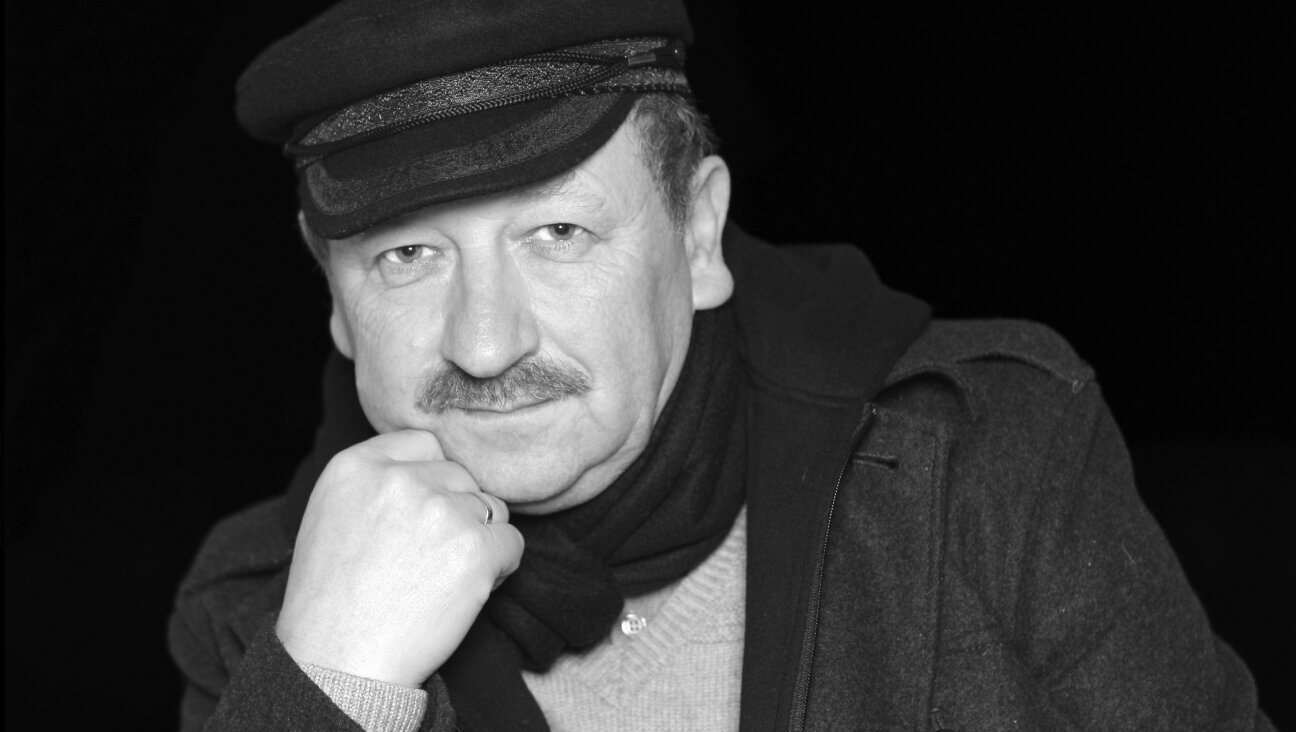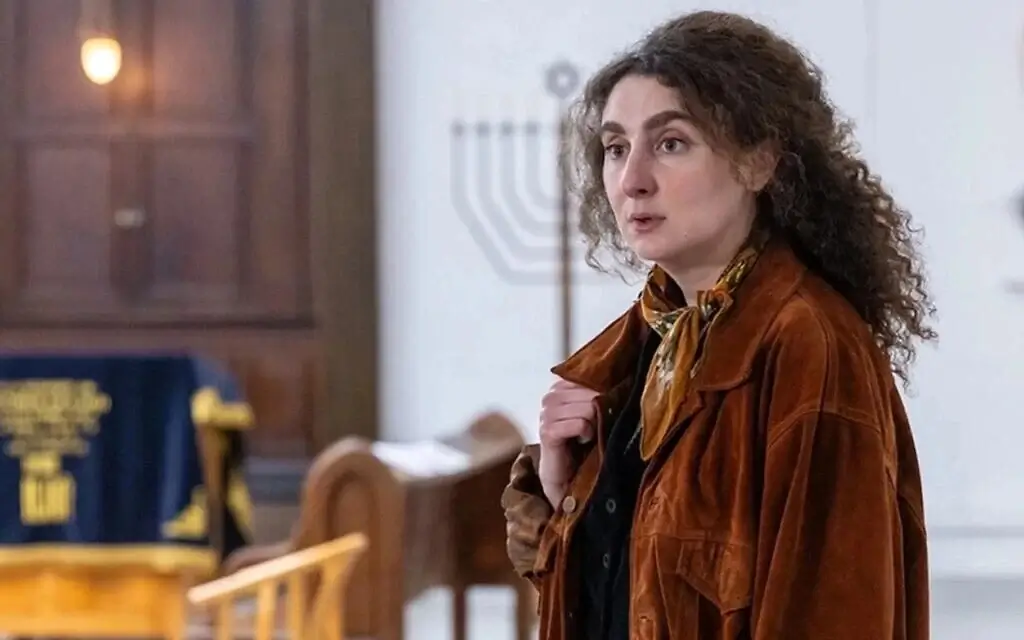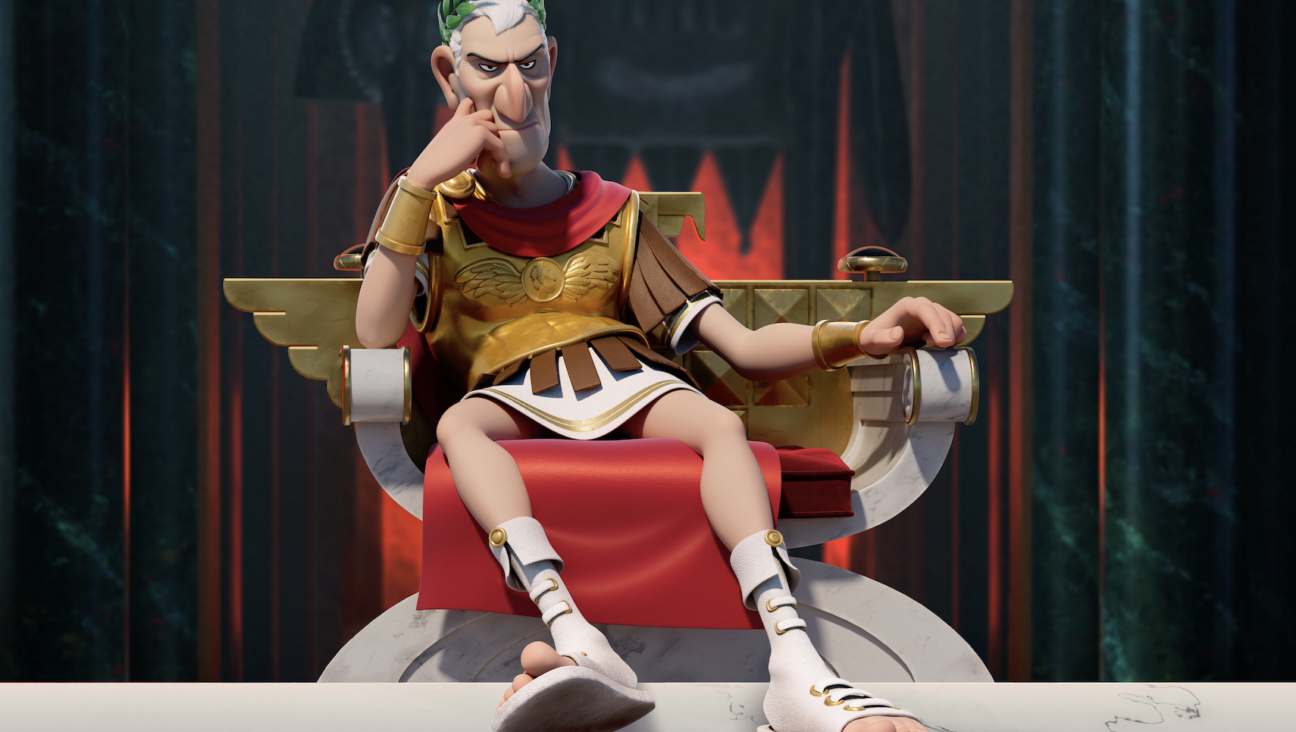Superstition Vies With Faith at Yiddish New York

Image by Courtesy of Deborah Ugoretz and Tine Kindermann
There they are, in Sanford Drob’s “Expulsion:” a man and woman, draped in animal skins, seized with grief – the woman gazing forward, determined but horrified, the man covering his face with his hand – and wearing armbands emblazoned with yellow Jewish stars, the word “Jude” at their centers.
It’s a painting that, despite the obviousness of its concept – it’s not news that the word “expulsion” has, for Jews, a multitude of painful meanings – produces a strange sense of imbalance. Is the work a commentary on the present? The past, The future? Are the man and woman Adam and Eve? Joseph and Mary, en route to Egypt? Is the painting an allegory about contemporary refugees?
At least one of those questions has an answer – the figures are Adam and Eve, Drob confirmed – but the imbalance, perhaps, is the point. So it goes with many of the artworks featured at the Yiddish New York exhibit “Trees of Life and Evil Eyes – a Contemporary Take on Superstition, Symbols and Mysticism in Today’s Jewish Worlds,” open through Wednesday, December 28th at the Clemente Soto Vélez Cultural and Educational Center’s Abrazo Interno Gallery.
After all, mysticism is a reframing of the world, and one that often dissolves boundaries presumed to be solid.
“In a world that’s more scientific and rational, where do these three things — superstition, symbolism and mysticism — fit into our world?” asked Deborah Ugoretz, who, along with Tine Kinderman, curated the exhibit. The duo previously curated the inaugural Yiddish New York visual arts exhibit in 2015, with the theme “The Jew as Other.”
It would be easy to interpret “Expulsion” as a work of realism, especially compared to the objects surrounding it, including Susan C. Dessel’s rotund conceptual sculpture “ph! ph! ph!…” and Isaac Roller’s violent, fantastical wall sculpture “Djinni.” Yet the abstraction and imagination of those works highlight, in Drob’s, a careful defiance of strict realism: Its blunt, static lines and curves and straight-backed, stoic-faced figures are reminiscent of representational folk art.
“The folk arts are very strong in the Jewish visual arts tradition,” Kinderman said. “Some of the submissions that we got were actually hamsas or amulets, which were lovely and beautiful, but we wanted more of an interpretation, rather than a representation.”
The interpretations included here range from the surprising and evocative – “Expulsion,” for instance – to the trite, like Debbie Schore’s “Gezunterheit,” which, consisting of a set of pill bottles, some containing pills, others religious objects, suggests a parallel between the uses and pitfalls of perception-altering chemicals and those of religion.
At its best “Trees of Life and Evil Eyes” reflects thoughtfully on the mutable power of symbols. In an exceptional example, one wall features three different representations of fire: Terry Marks’ painting “Burning the Evidence,” Yoav Friedlaner’s photograph “The Burning Bush, Queens, NY,” and Kelly Ann Hanrahan’s painting “Tribes 1.” In Marks’ work, also the exhibit’s poster art, a young, nude woman stares dreamlike into a fire, surrounded by birds — including one escaping a neat, square cavity in her chest — as buildings burn behind her. To her left, Friedlander’s photograph shows a bonsai tree leaping with flames in a barren, still room, and a group of Hasidim, painted in broad, blocky strokes, burn papers in “Tribes 1.”
Taken separately, each of those works might appear to be a simplistic interpretation of fire as a destructive symbol of divine power. Together they form a more nuanced examination of the subject, their shared theme creating a sense of entrancement and suspension.
“Interpretive art kind of broadens the textual-ness of Jewish teachings,” Ugoretz said. “To be able to take something written in a Jewish context and make it visual is a way to broaden and open it for deeper understanding.”
“I think the value of art in general – certainly at this exhibition – is to open new avenues of perception and understanding in the viewer,” she continued, “and to challenge them to try to sort of get to work.”
The Forward is free to read, but it isn’t free to produce

I hope you appreciated this article. Before you go, I’d like to ask you to please support the Forward.
Now more than ever, American Jews need independent news they can trust, with reporting driven by truth, not ideology. We serve you, not any ideological agenda.
At a time when other newsrooms are closing or cutting back, the Forward has removed its paywall and invested additional resources to report on the ground from Israel and around the U.S. on the impact of the war, rising antisemitism and polarized discourse.
This is a great time to support independent Jewish journalism you rely on. Make a gift today!
— Rachel Fishman Feddersen, Publisher and CEO
Support our mission to tell the Jewish story fully and fairly.
Most Popular
- 1

Culture Cardinals are Catholic, not Jewish — so why do they all wear yarmulkes?
- 2

News School Israel trip turns ‘terrifying’ for LA students attacked by Israeli teens
- 3

Fast Forward Ye debuts ‘Heil Hitler’ music video that includes a sample of a Hitler speech
- 4

Fast Forward Student suspended for ‘F— the Jews’ video defends himself on antisemitic podcast
In Case You Missed It
-

Yiddish קאָנצערט לכּבֿוד דעם ייִדישן שרײַבער און רעדאַקטאָר באָריס סאַנדלערConcert honoring Yiddish writer and editor Boris Sandler
דער בעל־שׂימחה האָט יאָרן לאַנג געדינט ווי דער רעדאַקטאָר פֿונעם ייִדישן פֿאָרווערטס.
-

Fast Forward Trump’s new pick for surgeon general blames the Nazis for pesticides on our food
-

Fast Forward Jewish feud over Trump escalates with open letter in The New York Times
-

Fast Forward First American pope, Leo XIV, studied under a leader in Jewish-Catholic relations
-
Shop the Forward Store
100% of profits support our journalism
Republish This Story
Please read before republishing
We’re happy to make this story available to republish for free, unless it originated with JTA, Haaretz or another publication (as indicated on the article) and as long as you follow our guidelines.
You must comply with the following:
- Credit the Forward
- Retain our pixel
- Preserve our canonical link in Google search
- Add a noindex tag in Google search
See our full guidelines for more information, and this guide for detail about canonical URLs.
To republish, copy the HTML by clicking on the yellow button to the right; it includes our tracking pixel, all paragraph styles and hyperlinks, the author byline and credit to the Forward. It does not include images; to avoid copyright violations, you must add them manually, following our guidelines. Please email us at [email protected], subject line “republish,” with any questions or to let us know what stories you’re picking up.
















